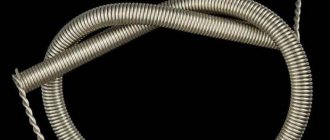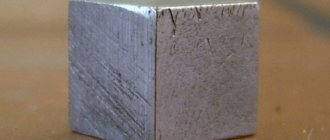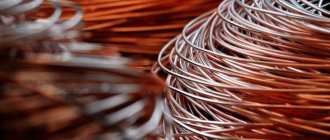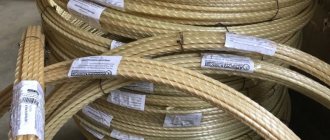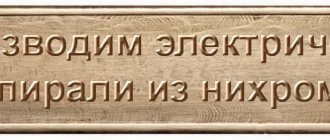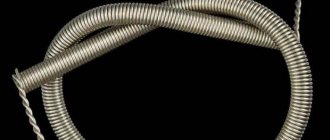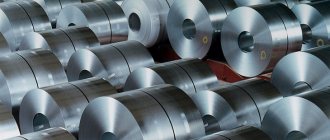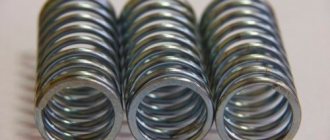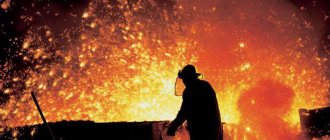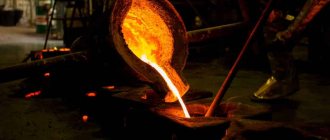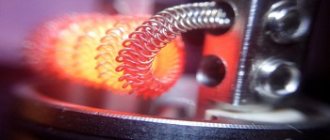Compound
Nichrome contains about 20% nickel and up to 80% chromium.
In addition, the alloy may contain additives in the form of manganese, aluminum, iron, silicon, etc.
The introduction of alloys into the nichrome composition increases the performance indicators and technical parameters of the metal:
- nickel and iron improve machinability;
- iron, titanium, aluminum and manganese reduce resistance to elevated temperatures;
- In the presence of iron in the alloy, nichrome acquires magnetic properties.
Increasing additives can degrade the characteristics of the metal.
The amount of nickel determines the temperature that the heating elements can withstand.
The chromium content in the alloy should be no more than 20%. An increase in the amount of chromium increases the brittleness and impairs the machinability of the metal. When its content in the alloy is more than 30%, cold rolling and drawing of the material becomes impossible.
The strength of the protective film and oxidation resistance depend on the amount of chromium.
Properties of nichrome
The alloy is characterized by good ductility and high electrical resistance. Its value can range from 1100 to 1400 Ohm mm²/m, depending on the type of metal.
Table 1. Technical characteristics of nichrome.
| Options | Indicators |
| Strength | 650-700 MPa |
| Melting temperature | 1100-1400°С |
| Working temperature | 800-1100°С |
| Density | Up to 8200-8500 kg/m3 |
| Resistance | 650-700 MPa |
| Coefficient of thermal conductivity | 11.3 W/(m K) |
| Linear thermal resistance coefficient | 14·10¯⁶Kˉ¹ |
| Ultimate tensile strength | 0.65-0.70 GPa |
Products made from nichrome are easily deformed while maintaining the given shape.
Nichrome does not have magnetic properties, with the exception of an alloy that contains an iron alloy.
Figure 2. Heating element.
Nichrome is a precision alloy - the base is nickel 55-78% and chromium 15-23%
Precision are metal high-alloy alloys that are distinguished by their precise chemical composition and calculated physical and mechanical parameters. Nichrome belongs to this large group of materials. It has high resistance and a high melting point. This property contributes to the fact that nichrome wire is actively used in electric heaters of various powers.
In this section, the client can familiarize himself with the description and types of this material, its characteristics, and areas of application.
general description
Nichrome is an alloy of:
• Ni, as a percentage of volume 55-78%; • Mn - 1.5%; • Cr - 15-23%.
The remaining volume of the alloy is occupied by Fe.
With a bulk density of 8200-8500 kg/m3, the alloy has a melting point in the range of up to 1400 degrees. The resistivity of Nichrome per linear meter is in the range of 1-1.1x10-6 Ohm m
The alloy has a working temperature of up to 1100 degrees. Nichrome maintains mechanical strength at the level of 0.65-0.7 GPa (tensile). Nickel-chromium alloy with the specified parameters is used for heat sources:
• Electric resistance furnaces; • household and technical stoves; • soldering equipment; • air heaters, etc.
Due to its properties, the material is actively used in precision laboratory installations.
Nichrome brands
The most common brands in the industry include:
- X20N80 is a classic alloy containing about 20% chromium and 80% nickel;
- X15N60 - the alloy has reduced chromium and nickel content, increased iron content to 25%;
- Kh20N80-N (-N-VI) and Kh15N60 (-N-VI) - alloys produced in vacuum induction furnaces;
- N50K10, X25N20 - grades of nichrome used for work at temperatures up to 900°C.
Alloys produced in vacuum induction furnaces are distinguished by the fact that their electrical resistance changes little with temperature changes.
Explanation of brands:
- X – chromium (Cr);
- N – nickel (Ni);
The numbers indicate the percentage of the composition.
Additional letters mean:
- VI - vacuum induction melting;
- H - category of heating elements;
- C - use in resistance elements;
- Heating element - intended for dry type electric heaters.
For example, the brand X20N73YUM-VI indicates: chromium content - 20%, nickel - 73%, aluminum - 3%, molybdenum - 1.5%, manganese - up to 0.3%, titanium - up to 0.05%, iron - 2 %, carbon - up to 0.05%. The alloy was smelted using the vacuum induction method.
The purpose and properties of nichrome products are determined by the chemical composition of the alloy.
International designations
In the international names of nichrome you can find the following designations:
- Cronix 80;
- NiCr80/20;
- Nichrome V;
- Chromel A;
- HAI-NiCr 80;
- Ni80Cr20;
- Nikrothal 8;
- Resistohm 80;
- euronichrome.
European analogues of ferronichrome: NiCr60/15, Ni60Cr15, ChromelCN6, Nikrothal 6, Nikrothal 60, CroniferII, AlloyC.
Choosing nichrome
How to choose nichrome wire for specific tasks? It is necessary to pay attention to 3 criteria:
Marking. The presence of the letter “H” in the designation indicates that the product is suitable for the manufacture of heating elements with a diameter of up to 0.2 mm.
The “C” marking warns that the area of application is the manufacture of resistance elements. The abbreviation TEN means that nichrome thread can be used in the production of tubular electric heaters.
Diameter of nichrome wire. It ranges from 0.05 to 12 mm. The weight of the skein and resistance depend on the size. The dependence is simple - the smaller the diameter, the greater the electrical resistance.
The diameter of the wire produced by manufacturers appears to be in the range of 0.05-12 mm. The diameter of the nichrome wire determines its cross-section, the weight of the coil and the corresponding objective resistance.
Welding of metal structuresFeatures of cold rolled sheets - production technology, features, dimensions, properties and markings
Technical features of hot-rolled sheet - classification, manufacturing method, application options and processing features
Manufacturer. Be sure to check which standard (GOST or TU) the product is manufactured according to. The presence of accompanying documents and certificates is the key to a quality product.
Advantages and disadvantages
Nichrome alloys are characterized by high electrical resistance.
The resistivity of nichrome is 10 times higher than that of galvanized steel and 70 times higher than that of copper.
Other advantages include:
- high mechanical strength and hardness;
- heat resistance and absence of temperature deformation;
- low specific gravity and good ductility;
- resistance to corrosion and aggressive environments;
The material is easy to process: sharpening, stamping, welding, etc. It does not change its characteristics when exposed to high temperatures.
Due to its resistance to corrosion and aggressive external environments, the alloy has an almost unlimited service life.
The disadvantages of the material include high cost.
Reducing the percentage of chromium in the alloy makes the product cheaper, but also reduces the technical properties of the material.
Stamps
Two grades of alloy are considered widespread and in demand in industry: X20N80, X15N60. Decryption example:
• X – Chrome; • 20 – percentage of Chromium in the alloy; • N – Nickel; • 80 – percentage of Nickel.
Also, auxiliary additives based on Zirconium can be introduced into the alloy. The index H is added to the designation.
In some cases, the manufacturer enters the index of the Nichrome production method into the name. For example, “-VI” means induction melting under high vacuum.
Making wire and tape from nichrome
Almost all electric stoves and electrical appliances use nichrome wire, thread or tape as heating elements.
There are several ways to make products from nichrome:
- Wire and thread drawing with intermediate heat treatment. Immediately before drawing, wire rod with a diameter of 6-8 mm is heated in special furnaces to a temperature of 1170-1230°C and quickly cooled. The heating temperature of the workpiece depends on the composition of the alloy. The next stage is pickling the wire rod in a mixture of hydrochloric and nitric acid with water.
Nichrome wire drawing is performed using high pressure. The production of products by drawing method is regulated by the requirements of GOST 8803-89
- Drawing of a hot-rolled billet to obtain a nichrome strip. This method allows the output to be a high-quality strip that exactly matches the profile and cross-section of the drawing channel. The resulting tape is of high quality and has no sharp edges.
- Cold drawn broach. The method is used for the production of wire and threads from nichrome. It is carried out without preheating the workpiece. Regulated by GOST 12766.1-90
- Cold rolling. Used for making nichrome tape. Performed in accordance with the requirements of GOST 12766.2-90.
- Flattening - used to produce strips from precision alloys with high electrical resistance. Performed in accordance with GOST 12766.5-90.
Nichrome tape.
The dimensions, mechanical properties and other parameters of nichrome wire are regulated by state standards or technical specifications.
Production
The manufacturing technology is based on pressure treatment using expensive equipment - mills, presses, furnaces. There are 3 methods of obtaining:
- Rolling. Nichrome is quite plastic, which makes it possible to produce wire from it by “cold” rolling. Large circles are produced by “hot” rolling.
- Drawing. It involves pulling workpieces (wire rods) through a gradually narrowing hole. The operating speed of the operation does not exceed 25 m/s. After obtaining the required diameter, the wire is subjected to thermal and chemical treatment.
- Pressing. Blanks are obtained by extruding the heated alloy through holes in the fixture matrix.
Areas of use
High corrosion resistance, the ability to work in aggressive conditions, and high-quality technical characteristics allow the material to be used in various fields.
In industrial installations and electrical equipment:
- high temperature electric furnaces;
- ventilation dryers;
- boilers and heat exchangers;
- welders;
- single-core and multi-core electrical wires;
- structural elements of metal-smelting equipment;
- powder paint polymerization chambers;
- devices for cutting foam;
- resistors, rheostats.
Heating elements made of nichrome are installed in car cigarette lighters, glass and seat heating systems in cars.
Special grades of complex alloyed nichrome with a low coefficient of electrical resistance are used as a heat-resistant coating when performing thermal spraying.
At home
The material is used in almost all modern household appliances:
- electric stoves and ovens;
- heaters and boilers;
- washing machines and toasters;
- hair dryers and irons;
- electric soldering irons and wood burning devices;
- electronic atomizers and light bulbs.
The use of spirals in household electric stoves.
Nichrome threads are widely used in medicine as a suture material during intracavitary surgical and plastic operations.
For each application, certain grades of alloys with optimal technical characteristics are produced.
Purpose
The use of nichrome wire in various fields of activity is due to its advantages. In instrument making it is used as a unit of resistors, rheostats, and heaters. Cables and ropes are produced from large-diameter blanks.
Many household appliances (toaster, soldering iron, iron) contain nichrome. In medicine, nichrome threads are used in plastic surgery and intracavitary interventions.
Diamond cutters for stone: options, features, how to chooseLLC GC "TransStroyKomplekt" is a reliable supplier of cast iron products in Russia
Features of diamond blades for wet cutting
The clever “Kulibins” manage to design wood cutters and burning devices from nichrome rods.
What is Resistance Heating Alloy
Resistive materials are materials that heat up to high temperatures when current passes through them.
The reliability, quality and technical characteristics of heating elements depend on the composition of the material.
The main types of resistive alloys include:
- Nichromes are alloys of nickel and chromium.
- Ferkhali - alloys of iron, chromium and aluminum.
- Multicomponent alloys, in which, in addition to chromium, aluminum, iron, alloying elements are added - copper, manganese, silicon, titanium.
The melting point of multicomponent alloys is 1500°C, and the service life of heating elements is 2-3 times longer than nichrome products.
Basic information and brands of nichrome
Nichrome is an alloy of nickel and chromium with additions of manganese, silicon, iron, and aluminum. The parameters of this material depend on the specific ratio of substances in the alloy, but on average they lie within the limits:
- specific electrical resistance - 1.05-1.4 Ohm*mm 2 /m (depending on the brand of alloy);
- temperature coefficient of resistance - (0.1-0.25)·10 −3 K −1;
- operating temperature - 1100 °C;
- melting point - 1400°C;
In tables, resistivity is often given in µOhm*m (or 10 -6 Ohm*m) - the numerical values are the same, the difference is in dimension.
Currently, there are two most common brands of nichrome wire:
- Х20Н80. It consists of 74% nickel and 23% chromium, as well as 1% each of iron, silicon and manganese. Conductors of this brand can be used at temperatures up to 1250 ᵒ C, the melting point is 1400 ᵒ C. It is also characterized by increased electrical resistance. The alloy is used for the manufacture of elements of heating devices. Specific resistance – 1.03-1.18 µOhm m;
- Х15Н60. Composition: 60% nickel, 25% iron, 15% chromium. Operating temperature is no more than 1150 ᵒ C. Melting point – 1390 ᵒ C. Contains more iron, which increases the magnetic properties of the alloy and increases its anti-corrosion resistance.
You will learn more about the grades and properties of these alloys from GOST 10994-74, GOST 8803-89, GOST 12766.1-90 and others.
As already mentioned, nichrome wire is used everywhere where heating elements are needed. High resistivity and melting point make it possible to use nichrome as a base for various heating elements, from a kettle or hair dryer to a muffle furnace.
Resistivity of nichrome and other alloys for heaters
Electrical resistivity determines the ability of a metal to prevent the passage of current. It is calculated as the ratio of the electric field to the current density and is measured in Ohm mm²/m.
Table 2. Resistivity of main alloys suitable for heating elements.
| Alloy | Resistivity | |
| ||
| 80 – Nickel, 20 – Chrome | 1.0803 Ohm mm2/m | |
| 80 – Nickel, 20 – Chrome | 1.18002 Ohm mm2/m | |
| 35 – Nickel, 20 – Chrome, 45 – Iron | 1.01382 Ohm mm2/m | |
| ||
| 73 – Iron, 22 – Chrome, 5 – Aluminum | 1.45425 Ohm mm2/m | |
| 74 – Iron, 22 – Chrome, 4 – Aluminum | 1.35453 Ohm mm2/m | |
| 81 – Iron, 15 – Chrome, 4 – Aluminum | 1.35453 Ohm mm2/m | |
| ||
| 55 – Copper, 45 – Nickel | 0.4986 Ohm mm2/m | |
| 89 – Copper, 11 – Nickel | 0.1495 Ohm mm2/m | |
| 98 – Copper, 2 – Nickel | 0.0498 Ohm mm2/m | |
The main factors in choosing an alloy for the manufacture of heaters are the combination of high electrical resistance and the ability to withstand extremely high temperatures for a long time.
Calculation of an electric spiral made of nichrome
The parameters of the spiral can be calculated using electronic calculators on the manufacturers’ website. By specifying the heater power, supply voltage and wire diameter, you can calculate the length of wire required for the heater coil.
Resistance calculation
It is calculated based on the diameter of the wire used or the cross-sectional area of the tape.
The total length of the wire is multiplied by the resistivity of one meter of conductor with the appropriate cross-section.
If the brand of alloy is known, the resistivity of the wire is taken from tables located in technical reference books, GOST or on the Internet.
If the alloy grade is unknown, the performance of the wire or finished spiral can be measured with a multimeter.
Using an online calculator, you can make a preliminary calculation of the spiral, but to accurately calculate the parameters of the heater, many more factors should be taken into account.
Nichrome spirals.
Length calculation
The length of the nichrome spiral depends on the resistivity and diameter of the wire and is determined by the formula: L=(Rπd2)/4ρ.
- R – wire resistance;
- d – wire diameter;
- ρ – resistivity of nichrome;
- π – constant = 3.14.
We take ρ nichrome from the table GOST 12766.1-90: ρ=1.0÷1.2 Ohm mm2/m.
Table 3. The relationship between current strength, diameter and cross-section of nichrome.
| Permissible current (I), A | 1 | 2 | 3 | 4 | 5 | 6 | 7 |
| Diameter (d) of wire at 700°C, mm | 0,17 | 0,3 | 0,45 | 0,55 | 0,65 | 0,75 | 0,85 |
| Wire cross-section (S), mm | 0,0227 | 0,0707 | 0,159 | 0,238 | 0,332 | 0,442 | 0,57 |
Example:
It is necessary to calculate the length of the wire for the spiral of the electric stove.
Tile power P = 800 W.
Mains voltage U=380 V.
Solution:
- We determine the current strength: I = P/U = 800/220 = 3.64 A.
- We determine the wire resistance R = U/I = 220/3.64 = 61 Ohm.
- Based on these data (see Table 3), we select d=0.55 mm; S=0.238 mm.
Then the wire length l = SR / ρ = 0.238 61 /1.1 = 13.2 m = 13,200 mm.
- L—wire length (mm);
- S—wire cross-section (mm);
- R—wire resistance (Ohm);
- ρ - resistivity (for nichrome ρ=1.0÷1.2 Ohm mm²/m).
Basic information and brands of nichrome
Nichrome is an alloy of nickel and chromium with additions of manganese, silicon, iron, and aluminum. The parameters of this material depend on the specific ratio of substances in the alloy, but on average they lie within the limits:
- specific electrical resistance - 1.05-1.4 Ohm*mm 2 /m (depending on the brand of alloy);
- temperature coefficient of resistance - (0.1-0.25)·10 −3 K −1;
- operating temperature - 1100 °C;
- melting point - 1400°C;
In tables, resistivity is often given in µOhm*m (or 10 -6 Ohm*m) - the numerical values are the same, the difference is in dimension.
Currently, there are two most common brands of nichrome wire:
- Х20Н80. It consists of 74% nickel and 23% chromium, as well as 1% each of iron, silicon and manganese. Conductors of this brand can be used at temperatures up to 1250 ᵒ C, the melting point is 1400 ᵒ C. It is also characterized by increased electrical resistance. The alloy is used for the manufacture of elements of heating devices. Specific resistance – 1.03-1.18 µOhm m;
- Х15Н60. Composition: 60% nickel, 25% iron, 15% chromium. Operating temperature is no more than 1150 ᵒ C. Melting point – 1390 ᵒ C. Contains more iron, which increases the magnetic properties of the alloy and increases its anti-corrosion resistance.
You will learn more about the grades and properties of these alloys from GOST 10994-74, GOST 8803-89, GOST 12766.1-90 and others.
As already mentioned, nichrome wire is used everywhere where heating elements are needed. High resistivity and melting point make it possible to use nichrome as a base for various heating elements, from a kettle or hair dryer to a muffle furnace.
How to wind a spiral from nichrome
You can make a spiral from nichrome wire at home.
To do this, you need to select a wire of a suitable grade and calculate:
- wire length;
- spiral winding pitch;
- number of turns.
The length of one turn is determined by the formula:
l=π(D+d/2)=3.14(5+0.55/2)=32 mm.
Number of turns:
N=L/l=13 200/32=412 turns.
- d—wire diameter;
- L—wire length;
- I is the length of the turn;
- D is the diameter of the coiling rod.
The number of turns of wire when wound onto a tubular rod D=10 mm is 412 pcs.
In practice, they rarely wind spirals at home. It is easier to buy a heating element with the required parameters in a specialized store.
Homemade spiral winding.
How to determine nichrome?
Nichrome, as a slightly silver or white material, is not easy to recognize. In addition, it often has a dark gray tint associated with an oxide (oxidizing) film.
However, it is possible to determine the appearance of the material by the following characteristics:
- dark green film on the surface;
- turning the wire into a spiral after heating.
The last sign indicates the high resistance of nichrome to deformation.
ATTENTION . The mode of alternating long-term and short-term use of the thread will help maintain the quality characteristics of nichrome wire.
Temperature coefficient of resistance
The resistivity of an alloy changes when the material is heated or cooled.
The temperature coefficient of resistance (TCR) of nichrome is defined as the ratio of the change in electrical resistance to the change in temperature in degrees Kelvin, taken to the minus of the first power (Kˉ¹).
TKS of nichrome is determined by the formula: α= (R1 - R2) / R1 X (T1 - T2), where:
- R1 is the resistance value at the initial temperature;
- R2 - at final temperature;
- T1—initial temperature;
- T2—changed temperature;
- (R1 - R2) - difference in electrical resistance;
- (T1 - T2) - temperature difference.
Heating by 100°C increases the electrical resistance of nichrome by 2%.
Nichrome 60 vs Nichrome 80
The properties of nichrome are determined by the quantitative ratio of nickel and chromium in the alloy.
The more nickel in the alloy, the higher its maximum operating temperature:
- for nichrome X20N80 this figure is 1200°C;
- for alloy X15N60 - up to 1125°C.
The next important indicator is plasticity. It affects the machinability of the metal.
Nichrome 60 alloy was created by reducing the amount of nickel in the alloy and increasing modifying additives to reduce the cost of heaters.
The use of the more expensive X20N80 alloy is justified when operating devices at extremely high temperatures.
Effect of temperature and processing on resistivity
Thanks to the resistance of the metal opposing the flow of electricity, nichrome heaters generate heat.
Indicators may vary depending on various factors:
- Alloy temperatures. When the temperature increases from 20°C to 650°C, the resistivity increases by about 8%.
- Manufacturing and processing methods. The resistance changes after annealing and rapid cooling:
- Х20Н80 – increase by 6%;
- Х30Н70 – increase by 4%;
- Х15Н60 – increase by 2%.
Alloy X20N35 resistivity practically does not change during processing and temperature changes.
The ability to change resistivity depends not only on the alloy composition, but also on the cross-sectional size of the heater. Elements of a smaller cross-section react more strongly to changes in the temperature of the alloy than massive parts.
Soldering nichrome
With prolonged use of electric heating devices or overheating, the nichrome spiral may burn out.
You can connect elements made of nichrome to each other, as well as to steel, copper or their alloys by soldering, using tin-lead solder POS 50 or POS 61.
In addition, a flux is used from a mixture of technical petroleum jelly (100 g), glycerin (5 g) and zinc chloride powder (7 g), mixed to a pasty state.
Soldering is performed in the following order:
- the elements to be connected are cleaned with abrasive sandpaper;
- degreasing is performed using a ten percent alcohol solution of copper chloride;
- parts are treated with flux;
- the ends of the wire are tinning;
- soldering is in progress.
Tinning can be done using regular citric acid. To do this, a small amount of it is poured onto a wooden stand, the stripped ends of the parts to be joined are placed on the powder and heated with a soldering iron. The acid melts, covering the metal surface with a thin layer.
To remove residual citric acid, the ends of the wire are tinned again using rosin.
Soldering is performed using POS 40/50/61 solders.
Repairing a burnt-out nichrome spiral using solder is not suitable for devices whose heating exceeds 300°C.
Nichrome soldering.
How can I replace nichrome thread?
A modern analogue of nichrome is fechral (FeCgAl) - an alloy of iron, chromium and aluminum.
Fechral heaters are used in mechanical engineering, foundry industry, glass and ceramics production, and other industries.
The material is supplied in the form of wire, thread, spirals of various diameters or ready-made heating elements.
The advantages of fechral heaters compared to nichrome ones include:
- no scale;
- lower density;
- longer service life (2-4 times);
- the cost is 2-3 times lower than nichrome.
Protection of fechral heating elements is provided by aluminum film. When working in a non-oxidizing environment, the protective film should be restored by annealing in air (in an oxidizing environment).
At temperatures above 900°C, the metal becomes grainy and brittle.
Fechral heating elements must be placed on ceramic tubes, since at temperatures above 800°C the spirals can deform even under their own weight.
Fechral wire 0.5 mm X23Yu5T.
Peculiarities
Nichrome wire has a rare set of properties that make it almost irreplaceable in some areas. Among the distinctive characteristics:
Corrosion resistance. As you know, rust is the weak point of most metal products. In this regard, nichrome is unique - it does not oxidize under the influence of the environment and has a long service life.
High electrical resistance. The resistivity of nichrome wire reaches 1.1-1.4 Ohm*sq.mm/m. If we compare these figures with ordinary steel, then much less nichrome (in meters) will be needed to release the same amount of heat. This makes it possible to make structures made of nichrome alloys compact and light in weight.
Heat resistance. The two-component composition remains operational at a temperature of 1400 degrees. In this case, there are no temperature deformations.
Nichrome is an expensive material, but its outstanding strength, physical properties, and durability justify such a cost.
Nichrome insulation with silicone multi-core cable
Heat-resistant heating cable in silicone insulation based on X20N80 tape or wire is used in various heating systems and thermal treatment installations.
To insulate nichrome wire or tape, two-layer silicone insulation is mainly used.
The basis of the insulating material is silicone rubber, obtained on the basis of high molecular weight organosilicon compounds. In appearance, the insulation is similar to ordinary rubber, but differs from it in higher technical indicators:
- resistance to high voltages - breakdown voltage is 5,000 Volts;
- resistance to aggressive environments and atmospheric influences;
- fire resistance - the material does not burn and does not emit toxic smoke when burned;
- operating temperatures from -60°С to +180°С;
- increased strength and durability.
Silicone insulation can withstand short-term temperature increases up to 220°C without changing the structure and quality of the coating. It is not destroyed by ultraviolet and radioactive radiation. Does not lose its qualities under the influence of ionizing radiation up to 20 Mrad (20 x 106 kJ/kg).
For the manufacture of heat-resistant heating cables, mainly two-layer silicone insulation is used.
Nichrome in isolation.
Operating requirements
To ensure a long service life of nichrome products, it is important to follow certain rules:
- to prevent overheating, winding the heating cable on the frame in several layers is not allowed;
- the bend of the current-carrying core in the cable should not exceed five of its diameters.
The integrity of the conductor can be restored by mechanical twisting, threaded clamps or couplings, soldering or welding.
When you turn on a device with a nichrome heating cable for the first time, a small amount of smoke may be released due to the burning out of residual oil.
Nichrome spiral
